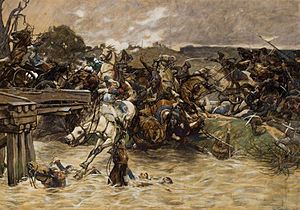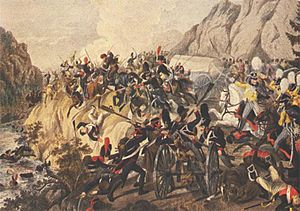Battle of the Katzbach facts for kids
Quick facts for kids Battle of the Katzbach |
|||||||
|---|---|---|---|---|---|---|---|
| Part of the German campaign of the Sixth Coalition | |||||||
 Battle of the Katzbach by Eduard Kaempffer |
|||||||
|
|||||||
| Belligerents | |||||||
| Commanders and leaders | |||||||
| Units involved | |||||||
| Army of Silesia | Army of the Bober | ||||||
| Strength | |||||||
| 80,000-95,000 | 60,000-75,000 | ||||||
| Casualties and losses | |||||||
| 1,000 killed and wounded (battle)
22,000 (campaign) |
Unknown casualties (battle)
30,000 (campaign) 103 guns |
||||||
The Battle of the Katzbach was a big fight during the Napoleonic Wars. It happened on August 26, 1813. The battle was between the French army, led by Marshal MacDonald, and a combined army from Russia and Prussia. This combined army was part of the Sixth Coalition and was led by Prussian Marshal von Blücher.
The battle took place near the Katzbach river in Silesia, which was then part of Prussia. A huge thunderstorm hit during the fight. On the same day, another important battle, the Battle of Dresden, was also happening. The Battle of the Katzbach ended with a victory for the Russian and Prussian forces. The French army had to retreat back to Saxony.
Contents
Getting Ready for Battle
Blücher's Advance
General Blücher led his army, called the Army of Silesia, forward on August 13. This was before a ceasefire, known as the Truce of Pläswitz, officially ended on August 17. The Allied army surprised the French, who didn't expect them to break the truce so quickly.
The Allies won several small fights. These victories really boosted the spirits of their new German soldiers. On the first day, Blücher and his main helper, August Neidhardt von Gneisenau, got separated. This meant they couldn't give orders for troop movements until later, which slowed down their army.
Challenges for the Allies
As the Allies moved forward, the French fought back harder. The Allied soldiers had to march at night often because of constant small battles and delays. The weather also became very bad. On August 20, Blücher's men came face-to-face with Napoleon's main army near the Bober river. They quickly retreated when they heard the French soldiers cheering, which meant Napoleon himself had arrived.
For the next five days, Blücher's army fought tough battles while the French chased them. Napoleon was personally leading the French chase. Blücher lost about 6,000 to 8,000 men in these fights between August 21 and 23. The French lost about the same number of soldiers.
Problems in Blücher's Army
Blücher's army started to struggle. One part of his army, led by Ludwig Yorck von Wartenburg, lost 5,000 men because they simply left. Many local volunteer soldiers, called Landwehr, deserted in large groups. Even the commanders of the different army groups complained that their army was falling apart. They blamed the mistakes of the main army leaders. Blücher even thought about firing his chief of staff, Gneisenau.
Napoleon's Orders to MacDonald
On August 23, Napoleon went back to Saxony with some of his best troops. He needed to face another Allied army led by Schwarzenberg. On that same day, Napoleon created a new army of 100,000 soldiers. He put Marshal Jacques MacDonald in charge of this new army, called the Army of the Bober.
Napoleon told MacDonald to push Blücher's army east of the Katzbach river. Then, MacDonald was supposed to move back to the west side of the Bober river. His job was to protect the side of the French armies fighting in Saxony and near Berlin. MacDonald was also allowed to attack if Blücher attacked first.
MacDonald's Delays
MacDonald didn't move his army for two days. This was because another Marshal, Michael Ney, misunderstood Napoleon's orders. Ney thought Napoleon wanted his entire army group to come to Görlitz, not just Ney himself. So, Ney's large group of soldiers was delayed.
Late on August 24, Ney finally handed over command to Joseph Souham. Souham spent August 25 moving his soldiers into MacDonald's battle line. Besides Ney's former group, MacDonald also had other large groups of soldiers and cavalry under his command.
Blücher's New Plan
On August 24, Blücher found out that Napoleon was no longer directly leading the French chasing him. At 7 PM that day, Blücher ordered his army to turn around. He sent out cavalry (soldiers on horseback) to find the enemy on August 25.
At 11 PM on August 25, MacDonald gave orders for his army to move to the town of Jauer the next day. His goal was to defeat Blücher or push him deeper into Silesia. However, MacDonald's messenger reached Souham four and a half hours late. Souham then moved his soldiers to Kroitsch at 11:30 AM instead of Liegnitz. This meant that only a small part of his soldiers would be able to join the battle.
The Battle of the Katzbach
The two armies unexpectedly met each other at 9 AM. This happened after MacDonald's troops crossed the Katzbach river, which was swollen from heavy rain. A sudden flood had washed away many bridges and made river crossings impossible.
In the middle of all the confusion and heavy rain, MacDonald seemed to react first. Even though his orders were to defend Napoleon's main army, MacDonald decided to attack. He sent about two-thirds of his army, around 60,000 men, to try and attack the side of the Russian and Prussian forces.
Confusion and Counter-Attack
But confusion struck again. The French groups of soldiers found themselves too far apart to help each other. Blücher ordered his right side of the army to attack. The soldiers' muskets were too wet to fire, so the battle was fought with bayonets and swords.
The remaining 30,000 French soldiers, who were supposed to hold back the Allied forces, were hit by a strong counter-attack. This attack came from the Prussian cavalry (soldiers on horseback). Without any help or extra soldiers, the French cavalry and some infantry groups were completely defeated by Blücher's entire army at 6:30 PM.
The rest of MacDonald's army had to retreat. Hundreds of French soldiers drowned in the Katzbach and the Raging Neisse rivers, which were overflowing.
Aftermath of the Battle
Casualties
We don't know the exact number of French soldiers lost on August 26. But by September 1, Marshal MacDonald's army had lost 30,000 men and 103 cannons. This included 12,000 soldiers killed or wounded, and 18,000 captured. Blücher's army lost about 1,000 men killed and wounded in the battle itself. Over the whole campaign, they lost about 22,000 men.




